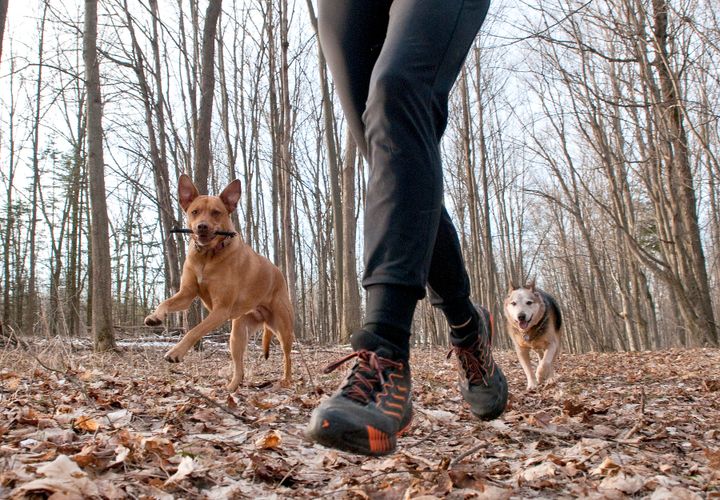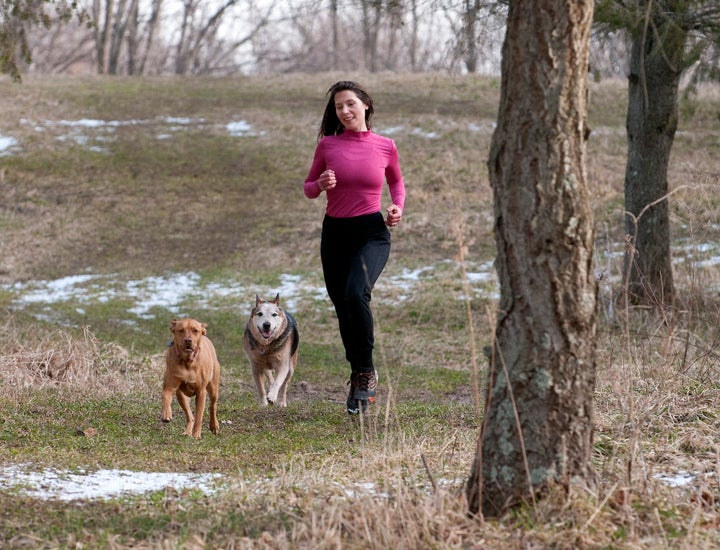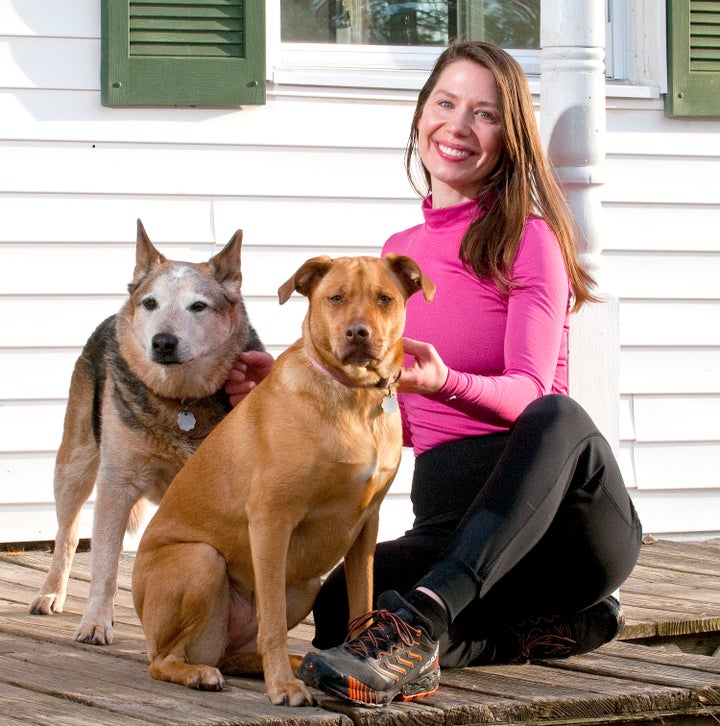
I recently attended a training session led by a man named Tom, who at least along my stretch of Lake Michigan coast, has a reputation for breaking stubborn dogs out of bad habits.
Standing in for my best friend’s husband to handle one of their dogs, I circled up with the others outside a large white barn, leash in hand. The dogs seemed nervous. So did their owners. It was the first night of training, and only one dog was off its leash: the trainer’s own.
Tom began with the typical demonstration: Come. Sit. Stay. His five-year-old pointer followed every command and no treats were given.
Next, Tom extolled the virtues of a prong collar, showing us how to jingle the metal chain as you walk to keep the dog’s attention on you, rather than passing stimuli. The pointer walked perfectly at his knee, no pulling.
Then Tom unleashed the dog, reached into his leather messenger bag, and brought out a live mourning dove. Sweeping the bird across the dog’s snout, he released it into the open air, yet the dog’s eyes stayed locked on Tom until given the command to chase. The instant he called the pointer back, the dog returned. Automatically. Amazingly.
For someone whose own boisterous rescue mix has barely emerged from puppyhood (and still retains a few bad habits), this was a sight to behold. I was beyond impressed and eager to bring this training home to my own dogs, until later in the session when I noticed something. The pointer had not moved.
Well after the demonstration ended, as Tom worked with other dogs, the pointer did not sit down or take a step. Instead it stood, stock still, in the centre of the barn, until directed to lie down (which it did immediately). Yet even then the dog never took its eyes off its owner. It was as if the other dogs in the barn did not exist.
Driving home, I kept wondering if I was crazy to feel that some essential part of that dog – something that belongs to dogs alone – had long been extinguished.
To be fair, I’d only been with the pointer for an hour, in the unusual setting of a single training session. But it got me thinking about the ways that we do or do not allow our canine companions to retain a degree of agency – a bit of freedom to make their own calls. About the careful balance each owner threads between having a dog that is wild – dangerous even – and a dog that is, essentially, a cute and useful robot performing our wills.

New research shows that dogs trained in an aversive manner produce significantly higher levels of cortisol during training sessions than those trained using reward-based tactics.
Aversive training focuses on using confrontational responses to unwanted behaviour (sharp leash corrections, verbal and physical force, prong and shock collars), while reward-based training heaps on praise (and usually treats) any time the dog does something we deem good.
This is one of the hottest controversies of the dog training world right now, but most trainers, regardless of their stance, would probably agree that some training is fundamental to being a responsible dog owner.
Part of me understands and embraces this. Yet increasingly, it seems, it’s not a little training we prize in a dog – it’s a lot.
Not just to address the truly dangerous acts of chasing cars, or biting, or the habits that make us want to give them up (tearing into the couch, endless barking). Now that most essential form of training feels like some mere baseline.
Now we train our dogs not to bark at all, not to sniff anyone’s butt, not to jump up, not to lick us too much, not to dig, and not to display any form of aggression.
Let me ask a ridiculous but serious question: At what point are we asking our dogs not to be dogs anymore? And in asking a dog to surrender most of their agency, what do we give up?
As a woman who runs on rural roads, this is a serious question for me, because a few times my dog’s sense of agency has proved critical to my own safety. I have an old dog and a new dog: Scruggs and Lucinda.
Scruggs is 13, part blue heeler, part unknown larger breed. For over a decade, he has run with me on the dirt roads surrounding my home. Confident, kind but never cuddly, he’s diplomatic with the other farm dogs we meet, alert and cautious with anyone who pulls over to talk to me.
After running together for so many years, I find myself looking to Scruggs because, so far, his instincts have not been off. There was only a single, terrifying instance when we disagreed about what to do with a possible threat, and he ended up being right.
It was late fall, breeding season, near a farm we ran by on a regular basis, but that morning someone had left a gate open. We had just passed by the property when all of a sudden, Scruggs swivelled around to a dead stop. When I turned I saw it: a large male ram charging us.
Fast, huge, the ram’s horns had not been cut. My first response was to bet on outrunning it. I pulled hard on the leash, but Scruggs didn’t budge. “Come on,” I ordered, jerking the leash again, but Scruggs simply lowered his head. A ridge of dark fur rose down his spine.
The ram was 20 feet away, then 15. “Come on!” I screamed, but Scruggs still didn’t listen. I had no idea what to do. The ram was closing in. At the last second, thinking of my own kids at home, I let go of his leash.
Scruggs lunged, a blur of teeth and spiked fur. In that second he became a dog I’d never seen before, yet incredibly, he never bit the ram. Instead he drove it back into its pen, then refused to leave, snarling, coming only at my millionth call. When he arrived back at my side, he was frothing at the mouth. He had been ready to fight, but had somehow understood – instinctually – not to engage the animal once it turned home.
Professional dogsledder Blair Braverman touches on this in a recent TED talk. Blair is my friend and, together with her husband, loves and races a beautiful team of Alaskan huskies. I’ve met those dogs. They are happy and healthy, and though I don’t know all the ins and outs of their training, I know Blair is a big believer in trust: trusting herself and trusting her dogs.

As a team they’ve accomplished amazing things, and I’m not just talking about crossing some long-distance finish line. I mean the moment something goes wrong. Like how once, deep in the woods during a sudden, whiteout blizzard in Michigan’s Upper Peninsula, they worked together to reach shelter. That day, it was Blair’s blind dog that led the team through the storm.
OK, you’ll say, “I’m not entering the Iditarod this year.” But doesn’t this happen on a smaller scale? Take Sadie – since I work remotely, I’ve offered to check in on the elderly boxer who belongs to a friend.
She has the best resting bitch face I’ve seen and sometimes I’ll be staring into my screen, stressed out, when she comes up and puts her paw on my knee. “Not yet, Sadie,” I’ll say, or “Soon.” But she doesn’t relent.
Paw to knee, over and over, until we’re both outside breathing the fresh air, taking in the sky. Wow, I’ll think. I needed this break. Her being herself – her dog-ness, which some might find obnoxious or in need of training – is exactly what makes her so wonderful.
As for my own old dog, I’ve stopped running him on the road. My new dog is so fast and Scruggs is so slow that now it’s downright comical to have them both leashed at once. So instead we’ve started running the 40 acres of wooded trails behind my house, where everyone can go their own speed.
Tail and nose high, there’s something about those woods that erases five years from Scruggs’ life. He’s happiest there – a joy to watch – and Lucinda is too: dashing full tilt, tongue in the wind, circling back to me in her own time.
Those woods, I’ve realised, are where they train me. They teach me how to trust my own instincts, how to be wild in every aspect of my life where I can still afford it.
I know the vast majority of dogs don’t have 40 acres (though I desperately wish they did). I know there is a balance to be found in training, and I believe in a certain degree of it. But as far as I can tell, beyond having their basic needs met, heaven on earth for every dog is whatever agency we can let them keep.
Which is to say, that half-trained dog of yours? The one who frustrates and annoys and embarrasses you? They’re probably perfect. You are training them, they are training you, and that’s a good thing. Someday it may even save your life. So if ever we should meet, they can totally sniff my butt.
Natalie Ruth Joynton’s writing has appeared in The Washington Post and the LA Times. In 2020, her first book, “Welcome to Replica Dodge,” placed as a finalist in the “Memoir” category of the Next Gen Indie Book Awards. Learn more at: natalieruthjoynton.com.
Do you have a compelling personal story you’d like to see published on HuffPost? Find out what we’re looking for here and send us a pitch.